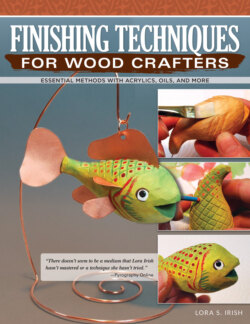Читать книгу Finishing Techniques for Wood Crafters - Lora S. Irish - Страница 8
На сайте Литреса книга снята с продажи.
Wood Surface Textures
ОглавлениеWhether you are carving or wood burning, the final texture and smoothness of the wood surface directly affects how evenly any coloring can be applied. Here is a summary of a variety of ways you can alter the final texture of your work and how that final texture can affect the painting. This list is sequential; you can do any number of these steps, and each step will make your surface smoother and smoother, but you don’t have to do all of the steps, and you can skip around as long as you stay in order. (This is generally speaking—but there are always exceptions, so experiment and see what works for you.)
1. Flat Plane Carving or Fine Shaved Carving.
Finish your wood carving by checking for any rough stop cuts, small un-cut chips in the deep crevices, and coarse V-gouge strokes. Clean these areas with a sharp bench knife before you begin any painting steps. While those small, loose fibers of wood might not show in the unpainted wood stage of your project, once you apply color they will become very obvious.
2. Sanding with 220- to 320-Grit Sandpaper.
Sanding smooths wood out, dulling or removing the texture of the cuts. Sanding grit can leave very fine, shallow lines in the wood that can catch blended colors or antiquing. Work the sandpaper or sanding pad in the direction of the wood grain whenever possible.
Sanding a relief carving.
3. Removing Dust.
A dust-free surface is always ideal. Remove any dust left over from carving and sanding steps with a soft cloth. While paint may cover up a small area of dust on your work, that paint will eventually pop off the project because it never adhered directly to the wood surface.
This project was sanded well after carving, which allowed for even application of the base colors. Of course, the splattering effect used on top of the base colors would effectively mask any uneven color application.
4. Polishing with Heavy Kraft Paper.
A crumpled 6" (15cm) square sheet of heavy kraft paper, like a piece of a paper bag or paper packing material, will polish a wood surface. Kraft paper works like an extremely fine sandpaper and removes those last few loose wood fibers or fine sanding lines.
5. Buffing with a Soft Cloth.
A lint-free, soft, cotton cloth can be used to buff or polish a wood surface after the carving or burning is finished. Not only does the cloth remove any remaining sanding dust or wood fibers, but it also can add a bit of sheen if you use firm pressure all over.
6. Burnishing.
A wood project can be burnished by rubbing the surface briskly with a small piece of similar wood. This rubbing creates a smooth, polished surface with a soft, semi-gloss sheen. Burnishing is a final step that allows you to get the smoothest surface possible, particularly when preceded by sanding and buffing. See page for more information on burnishing.
Burnishing is a good pre-treatment when you want easy blending of hues for both acrylics and oils.
Depth and Intensity of Carved Texture
Deep, textured cuts in your carvings will hold more shading color and more antiquing/staining than shallow cuts. You can choose to use a variety of cut depths in your carving, from very smooth, flat planes to deeply incised details, to capture more color changes in the finished project. A light texture in your carving, as shown in the tiki pieces, can accent your color work, especially when you are dry brushing or antiquing the final painting, by allowing color to concentrate in the textured areas. Heavy textures, as shown in the wood spirit, are wonderful for dry brushing, antiquing, and for faux wood, stone, and marble effects. The deep, textured cuts really grab the color.
